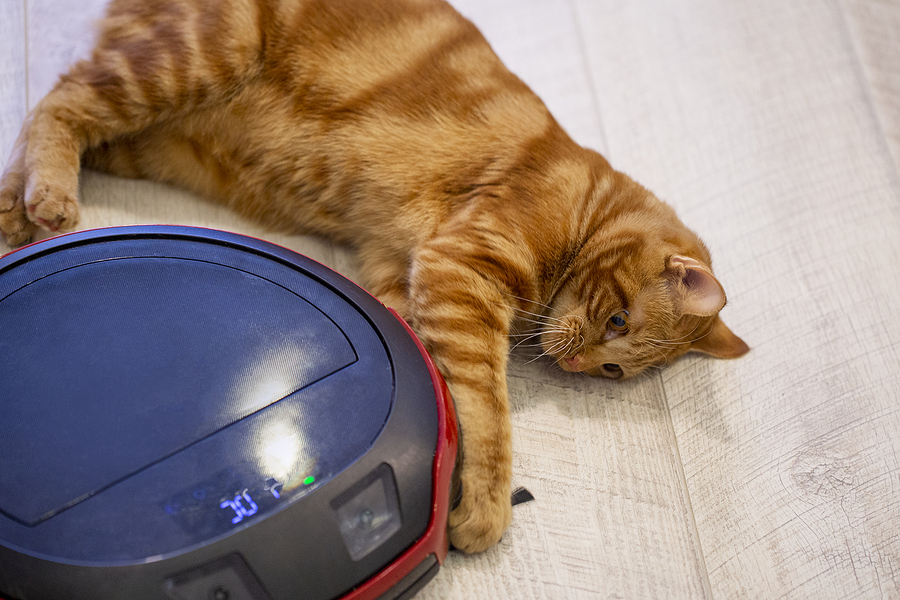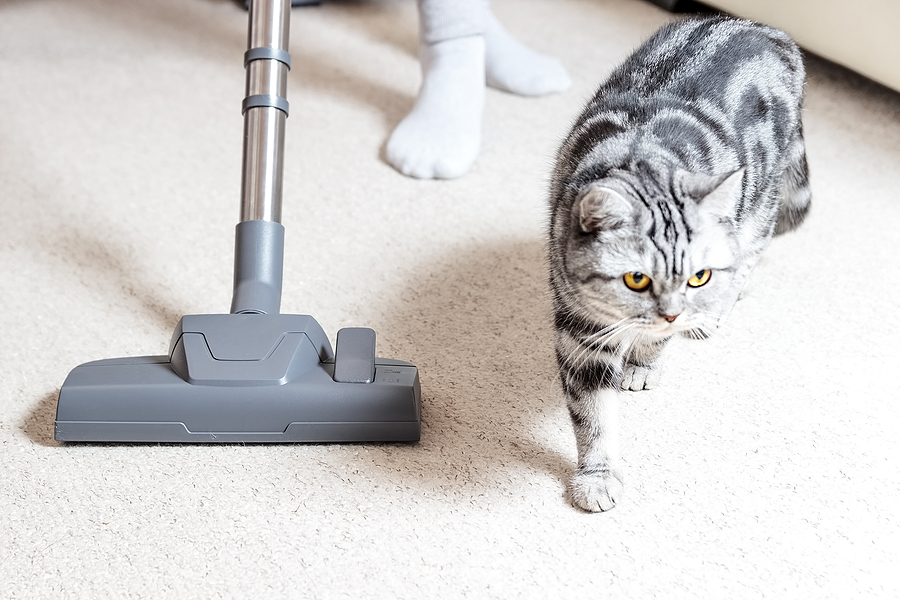When I pull out the vacuum, Mollie disappears. Fortunately, our house is large enough that she has plenty of “safe” places to hide – often the linen closet upstairs or inside a kitchen cabinet.
There’s a name for this fear: Zuigerphobia. It’s a specific phobia, which is an irrational, yet excessive fear of a particular object. This type of phobia creates an immediate anxiety response, often causing the person – or pet – to avoid the object whenever possible.
Debbie Martin, a veterinary technician specialist in behavior and an Elite Fear Free Certified Professional, says cats who are afraid of one sound typically have a fear of multiple sounds. That’s true for Mollie. She also dislikes fireworks and thunderstorms, and while she may not always flee, I can see that she is tense.
Martin says a cat experiencing a situation with frequent, unmanaged noise lives in constant fear and anxiety, which is not physically or emotionally healthy. She recommends giving the cat a safe haven in another room and providing treats, a meal, or special toy to occupy her time and create a positive association. Consider the addition of calming music (there is music composed specifically for cats), a white noise machine, and calming pheromones, such as Feliway.
Leave the vacuum out if possible, so kitty learns that it’s not always loud and bad. Praise and reward her if she sniffs it.
Ideally, desensitization should begin in kittenhood as a part of the socialization process. In contrast to Mollie, Sofiya, my Russian Blue, isn’t bothered at all by the vacuum; she had positive exposure to one as a kitten.
Although there is no research to substantiate their efficacy, Bach’s Rescue Remedy is a go-to choice for me for dealing with fearful situations. I offer a few drops in water or rubbed onto the ears before starting up the vacuum. Other Bach remedies include Mimulus, for fear of lightning and visits to the veterinarian with signs such as shivering or shaking, and Rock Rose, for terror and panicked behavior.
Jackson Galaxy’s Solutions were developed in conjunction with Jean Hofve, DVM, a holistic veterinarian. Based on flower essences, they are gentle and non-toxic and work in a similar way to the Bach remedies. Included are products such as Stress Stopper, Safe Space, and Scaredy Cat.
Before trying any medications or supplements, talk to your veterinarian to make sure they are appropriate for your cat. Any supplement that has an effect can also have potential undesirable effects or interactions with other medications your cat is taking.
Martin notes that a medication such as gabapentin could be considered “if the trigger cannot be avoided and there is no non-stressful starting point for desensitization.”
If you live in a small home with limited safe spaces, try teaching your kitty to go to an area such as the top of a tall scratcher, a counter, or a wall-mounted perch. Use the positive associations as mentioned above. Once the cat is comfortable with that routine, trying running the vacuum at the furthest distance from the safe space, or try playing a recording of the vacuum at a low volume. Take training slowly. During the training process, put your cat in a room away from the vacuum when you use it.
Once the sound is not an issue with the kitty, start over but with movement. Be sure to avoid the vacuum directly approaching the cat and keep an eye on her reaction. Watch for tension – “airplane” ears, dilation of pupils, a crouching position, swishing tail. The space around her safe zone will have to be vacuumed eventually, so watch for those reactions and take care of that area when she is otherwise occupied.
Run the vacuum in short intervals as a part of the desensitization process.
Once the deed is done and the noisy monster is back in the closet and your kitty has maintained a level of calm, offer lots of praise and a treat, special meal, or one-on-one playtime.
“Realizing that some cats will never be comfortable with the sound,” says Martin, “and managing their fear by giving them a safe place to go is the most Fear Free thing we can do for them.” That applies to Mollie. When I pull out the vacuum, that’s her clue to disappear.
Martin notes that orthopedic pain has been associated with a fear of sounds in dogs. She says there is no similar research in cats but notes that orthopedic pain in cats is a common problem that often goes unrecognized and untreated.
What about the Roomba?
I haven’t used a Roomba, the round, self-propelled vacuum featured in various cat memes. However, an informal survey found that it does not appear to be as traumatizing as a regular vacuum. Nancy Samler writes, “My former cat was afraid of it. My new cats are pretty fascinated with it and watch it. They don’t, however, ride on it as has been shown on fb videos.” Ariel Bartelmes says, “No one here cared for more than a day.” Robin Riley’s cat doesn’t like it and watches the Roomba from a high perch. Tracy Dion says, “My cats started off mildly curious but after a few days, they’re completely ignoring it.” And Inge Dagmar Manders writes, “Toby hunts it…. Charlie, who is terrified of normal vacuum cleaners, just looks at it.”

Few of us are thrilled with hauling out the vacuum and having a scaredy cat is a good excuse for procrastinating – until the cat fur collects in all the corners of the house!
This article was reviewed/edited by board-certified veterinary behaviorist Dr. Kenneth Martin and/or veterinary technician specialist in behavior Debbie Martin, LVT.








